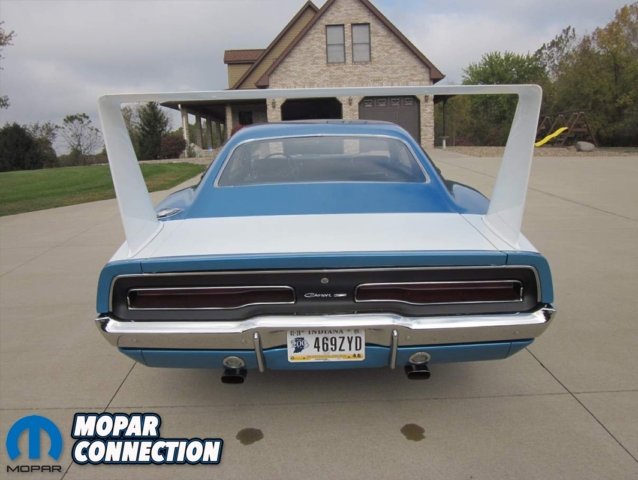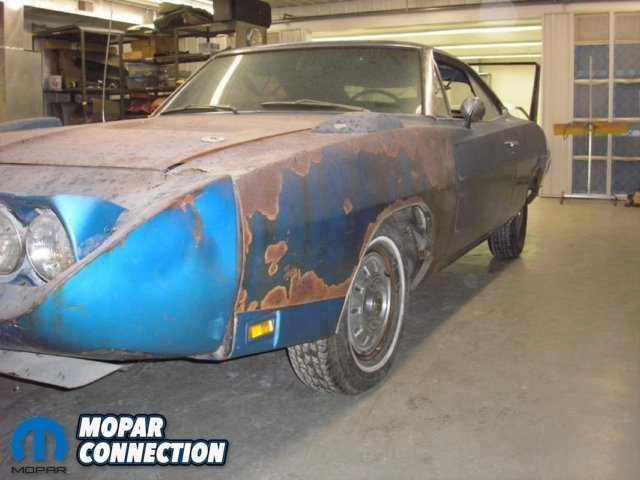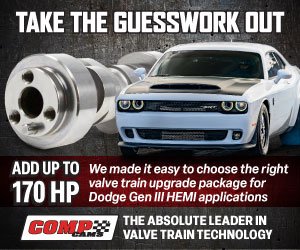
From a young age, John Borzych of Indiana was destined to be a car guy. Growing up, John spent a lot of time around cars, thanks to his grandpa owning a local gas station called “Borzych’s Shell” and his childhood friend, Timmy Lang whose father owned a body shop. In his early teens, John decided it was time for a car of his own. “I started mowing the church grounds and cemetery, baling hay for the farmers, milking cows after school, cleaning out grain elevators; you name it. I was doing it,” says John.
After saving up as much money as he could, he went car hunting. He decided he wanted a car that had a small body with a big block V8 engine under the hood and in his hunting, came down to two choices; a 1968 Chevrolet Camaro with a 396 4-speed or a 1967 Dodge Dart GTS with a 383 4-speed. Being as John was a smart guy, he decided to go with the Dart because there were a lot of Camaros around already and he didn’t want what everybody else had. The Dart was white with red interior and a black top.

Early on in his ownership, John didn’t drive the car much as he and his dad agreed that he would not drive it to school until his senior year in 1970-1971. Eventually, John started driving the Dart to school and decided to take it drag racing. One day, John showed his dad some Polaroids taken of him racing the Dart. His dad went ballistic and demanded the keys for the car. This was followed up by a serious lecture and then John’s dad blocked the car in with his backhoe for a month so John couldn’t take it. He told John if he ever raced it again, he would smash it with the backhoe and bury it out back.
Shortly after, John got his Dart back and eventually moved out of the house. In the spring of 1972, John’s never ending Mopar collection begun as he picked up a B5 Blue 1969 GTX 440 4-speed for $400 from a guy that wrecked it with no insurance. It was hit hard in the rear but the rest of the car was good and it ran. John started going to junkyards looking for a GTX that had been hit in the front so he could make one car out of two.
He made friends with the owner of L&W Auto Salvage in Valparaiso, Indiana and ended up buying a 1969 Road Runner that was hit in the front for a couple of hundred. With both cars in his possession, he took the front end off of the GTX and put it on the Road Runner. He then stripped the GTX for anything good remaining and scrapped the rest.

It was about this time that he lost his grandfather sadly. Shortly after, his friend over at L&W Auto Salvage called and told him that he had just gotten in a FJ5 Limelight 1970 GTX that was stolen and recovered. After talking to his dad for 2 weeks, John was given permission to buy the car. However, when he went to buy the GTX, it was already sold.
By stroke of luck, when the new owner of the GTX went back to L&W to buy some parts, the owner told him about John. The owner of the GTX reached out to John and the pair ended up swapping the GTX and some cash for John’s Dart. Sadly, two weeks later the new owner of the Dart had a tangle up with a semi-truck and wrote the car off. Thankfully he wasn’t killed.
In September 1972, John sold his Road Runner purchased his first and only E-Body; a FC7 Plum Crazy Purple 1970 Challenger R/T with a 383 4-speed. John tells us that it was around this time he earned the nickname, “Mopar John” which has stuck with him for all of these years. 1973 brought John a marriage to his first wife and some further changes to his Mopar collection. His mother-in-law gifted them a 1966 Barracuda Formula S with a 273 4-speed and John traded in the Challenger for his first new car, a 1973 Road Runner.

Over the next little bit, John worked on turning his GTX into a drag race car while stuffing a 1969 340 into the Barracuda. In 1974, he purchased a 1969 Dart Swinger from his brother-in-law’s brother and sold the Barracuda with its original 273. In 1977, after a close call at a drag strip with the GTX, John decided to park the car and hang up drag racing. With racing no longer being fun, he wondered what to do next.
He tells us, “I kept thinking in my head about a special car of some type; a classic car or a limited production car. A light finally went off in my head and it was a bright one! I remembered in one of my old HOT ROD magazines that there was an ad that had Richard Petty and a bunch of guys around a “special car”. I ripped through my old magazines until I found it. It was an ad for the 1970 Plymouth Superbird; a limited production car built for NASCAR. I had to have one so I started my hunt for a Superbird.”

Remembering one locally in TorRed, John went to talk to the owner. The owner told John they had only made about 50 of them and that a lot went overseas. When John asked if he would sell it, he said he would for $7,000. John thought the price was high and the owner told him if he didn’t buy it now, the price would be $8,000 the following year. John passed and continued to look.
Shortly after, John came across an ad in the Chicago Tribune for a Superbird for $800.00! The nose was bent up and the car needed some work. It was just what he was looking for. The timing just wasn’t right though as about that time, John’s wife got sick and needed to have some surgery. He learned about the cost of healthcare way back then and couldn’t afford to buy the car. Eventually, with the medical issues and bills behind them, John started saving for a Superbird.

While looking through the Chicago Tribune again one day, he came across a V-Code 440 Six Barrel automatic Superbird for sale for $2,800. He called right away and got a few more details before making the 3 hour drive out to see the car. John shares, “My wife and I went to check it out. It was Vitamin C Orange with a black vinyl top and black interior. We took it for a drive and really liked it. The seller said we could have it for $2,000 so I bought it. I was through the moon excited”.
The thrill didn’t last long though. After getting it home, John started cleaning it up. He went to get rid of some shag carpeting in the trunk and found some cardboard under it. When he removed the cardboard, he found a piece of Masonite strangely cut out in the shape of the trunk and when he removed the Masonite, he found the gas tank and frame rails! It turns out the car was from the Florida coast area and we all know how salt air and water can be on cars.

About the time that he bought the Superbird, John found out about the Superbird Club. Wanting to attend the 1978 National Club Meet but with his car needing work, John decided to buy another Superbird so he started searching. One day while working out on the road, he spotted a white 440 4-speed Superbird being driven by a young man in Chicago. John followed him until he got to his destination. He asked the owner if he would sell it in which the owner declined. John gave him his name and number in case he ever wanted to sell it.
Before finishing up the conversation, the owner told John that he did know of a yellow 440 4-speed Superbird for sale down the road for $1,000. John thanked the owner and made his way out to where the yellow car was supposed to be and sure enough, there it was. He talked to the owner and as he was told, it was for sale and the price was $1,000. The starter was out of the car and it needed new rear brake lines but otherwise it was in good shape. He agreed to purchase it, wrote a notarized contract, gave the owner partial payment and took the car home until the owner got the title from the bank. After two weeks, he got it and John now officially owned his second Superbird.

Oddly enough, the day he finalized the deal on Superbird #2, the young kid with the white one actually called and said he would sell it for $2,400. He had just got his girlfriend pregnant and the car needed to go. John passed on the car but told him to keep his number if the price came down. About six months later, the guy called and said his child was close to being born, the transmission on the car wouldn’t shift and he had sold the wing and fender scoops so he would take $450 for the car. That afternoon, John now owned three Superbirds.
He decided to use the white car as a parts car for the other two (John eventually sold it to a friend who restored it). He got the yellow one repainted and made the mechanical repairs before finally attending the 1978 Superbirds of America National Meet. While at the meet, he saw a Dodge Charger pull up with a wing and nose cone on it.
He recalls, “I honestly said out loud, what the heck is that thing? I had never seen one in my life. A couple of the more knowledgeable members told me it was a Charger Daytona and there were only around 500 made compared to almost 2,000 Superbirds. The more I heard about them, the more I wanted one. I also learned about Charger 500s at this time as well and decided I wouldn’t mind having one either.”

Once John got home, he remembered about a B5 Blue ’69 Charger 500 sitting in a local junkyard called Big Jacks. At the time he had originally found it, he had simply thought someone had wrecked it and just stuffed a ’68 Coronet grille into it. When he went back after the meet, the engine and transmission were gone along with the interior and wheels and tires; however it still had the special back window and all of the trim. He asked the yard owner if they would sell it in which he was told $50 could bring it home.
John quickly paid for the car and told him that he would be back on Saturday with his trailer to get it. John removed the fender tag to decode it while he waited for the weekend. When he arrived back on Saturday, he was told that while the owner was out of town, some yard workers took the driver side door off the Charger 500 and then crushed it. He then took John out to the back to see the crushed car before giving him back his $50.

In April 1982, John received a phone call from a friend in the club. His friend told him that there was a U-Pull It salvage yard near him called Avenue Auto Parts in Kansas City Missouri that had two ’69 Charger Daytonas in it; a B5 Blue 440 and a R4 Red 440. Besides the two Daytonas, there was also a ’69 Charger 500 Hemi car, a ’69 Charger sunroof car and some various others including a Studebaker Hawk, Lincoln Continental Hardtop and some two-seater Thunderbirds.
They were apparently a part of a large collection of cars that were impounded by the State of Missouri back in 1973. The owner of a used car lot had gotten into legal trouble regarding the titles to some of the cars he was trying to sell and the cars were impounded as a result. Since the police impound lot was not large enough to store the cars for a longer term until the issue could be figured out, they were sent to Avenue Auto Parts for storage.

Over time, the cars were moved to a far back corner of the property but remained off-limits to any of the customers looking for parts. Eventually though, people looking for parts slowly starting picking parts off of the seized cars; with the yard owner turning a blind eye. The cars were moved around a bit by the loaders, causing damage to them. The owner of the cars ended up going to jail and in 1982, the yard owner went to court regarding the ownership of the cars. The State ended up turned over the ownership and titles to the cars to the yard owner.
His friend told John that the local dam broke and flooded the yard so the yard owner was selling the cars. He was after the Hemi Charger 500 and gave John the name of the owner and his phone number to inquire about the Daytonas. “I called the owner and told him I wanted to buy the red Daytona. He informed me that I could buy it but I also had to buy the blue one. He said that there were so many parts missing that it would take both to make a nice car. I agreed but didn’t really want the blue Daytona because I thought it was ugly back then! Now I had to get the money and get to Missouri quick” John says.

He continues to say, “While driving my Superbirds, I would be asked if I wanted to sell one quite often. My answer was always no but I was smart enough to keep the contact names and phone numbers. Not too long before the Daytona deal, a guy called me from North Dakota and inquired about my yellow one. I called him back and told him that something came up and that I would sell him the Superbird. I described the car over the phone and we agreed on a price and a place to deliver the car. We met up to do the deal and he was all smiles.”
The next morning, John and his friend made their way to Missouri to pick up the Daytonas. John recalls, “When we got to the yard, the cars were still there and things went pretty good. The cars were in bad shape from all the years in outside storage. There was also some vandalism and parts missing as the owner had stated on the phone.
The red Daytona was missing its antenna, wipers, alternator, carburetor, air cleaner, distributor, wing and interior. The missing interior bothered me most because the broadcast sheet was gone! The cars had been moved around in the yard several times over the years and both suffered damage from the forks on the loader. The red Daytona was bent up on the bottom of the core support and radiator along with some damage to the driver’s quarter panel.”

“The blue Daytona had 24,000 original miles on it but was missing its antenna, wipers, alternator, radiator, fan, carburetor, wing and wheels and tires. It had damage to the driver’s side of the nose. The blue car also looked like it got some water in it from the yard flood since it was sitting on the ground. The owner informed us that the yard was broken into and vandals had used a tire iron on the trunk lids and eventually stole the wing off the blue car a while later. They did a lot of damage to the red car but never got it open. The owner removed the wing off the red car and put it inside a building for safe keeping. Even though it was part of the deal, they never found the wing!”
John loaded up the red one and went back two weeks later for the blue one. His friend that went with him decided he wanted the blue one and since John wasn’t a fan of it, he sold it to his friend with the agreement that he had first dibs down the road. Sadly, a short time later his friend got laid off and had to sell the car, so John bought it back. Over the next number of years, John put the two Daytonas into storage while he got back into racing with his GTX and collected parts for them, including wings. With his intentions to restore the red car, the blue one usually sat outside when storage was tight.

When values started going through the roof on the Daytonas, John sat down and started figuring out the restoration plans. One of the big factors was the missing broadcast sheet for the red car. All attempts to locate the sheet hit dead ends. After doing some research, John discovered just how rare the blue car was compared to the red one. With its basic hubcaps, B7 Blue buddy seat interior and white wing, it was one unique Daytona. This combined with the fact that it had its broadcast sheet led John to decide to restore the blue one first.
In the summer of 2007, John decided he wanted to attend the 40th Aero Warriors Reunion in Talladega in October 2009 with the blue Daytona so he needed to find somewhere to have it restored. John says, “I wanted a shop that was within a day’s driving range of my house and had already done an award winning restoration on a Daytona. Names like Roger Gibson, Nostalgia Lane and Vance Cummings were on my list. It was around this time, I saw a magazine article with Steve Fox’s black and red Daytona in it. While reading it, the names Paul Jacobs and Troy Angelly were mentioned. It just so happened I had bought a bunch of Superbird parts off of Paul a few years back.”

He continues to say, “I called Paul and I talked with him about Steve’s Daytona and asked if he would be interested in restoring another one. He said that I would need to bring the Daytona to his shop with all of the extra parts. He would have his partner Troy Angelly who does the body and paint there also.” In August 2007, John pulled the Daytona out of the shop, gave it a quick bath and loaded it up for the trip to Paul’s shop. Once he got to the shop, he unloaded it and the parts for Paul and Troy to look it. The car was very original in many aspects such as the original engine, transmission, rear end, interior and paint!
Paul agreed to restore the Daytona but told John that both of his shops were full and there was a waiting list. John informed him that he needed to have the Daytona done by October 2009 for the reunion meet. They told him that it was possible! John loaded the Daytona up and Paul said they would call a couple of months ahead of when they would be ready for to bring it in. That following winter, John worked hard buying as many NOS and assembly line NOS parts as possible.

Just after the 2008 Aero Meet, he got a call from Troy Angelly with some good news and bad news. He said Paul had gotten a promotion at work and had to scale back the number of cars that he was able to take on however he was willing to do the restoration at his own shop. He said Paul would consult on the restoration whenever needed and that he would have the car done for the 2009 Talladega meet as John had hoped.
In November 2008, the Daytona was dropped off at Troy Angelly Restorations, giving Troy just over 11 months to totally restore the Daytona in time for the meet. The guys at Troy’s shop quickly tore the car apart and got the body ready for metal work. The body of the Daytona was sent off to Redi-Strip where it was totally stripped down to the bare metal, exposing some of the nasty rust.
Since both of the front fenders were rusty, John opted to take the ones off of his red Daytona, replacing them with some other fenders he had (he eventually sold the red Daytona in 2015). The original hood was shot and the trunk lid had been damaged from the junkyard vandalism so John purchased an original Daytona hood, trunk lid and wing many years prior off the late Monroe Schellinger who had parted out a couple of Daytonas.

Rust was also found under the battery tray and in the door jambs so those areas were cut out and replaced with new metal patches. The interior floor pans were retained and only needed minor patches. Since the wing had been removed and the trunk lid was pried open, water got into the trunk and destroyed the pan. A replacement trunk pan was sourced from Auto Metal Direct along with lower quarter panels. John managed to find a NOS tail panel, rear valance and valance corner caps so those were installed. The damage to the nose cone as well as some rust on the trunk lid lip was repaired.
In May 2009, Paul and Troy approached John with a plan. They agreed to have the car ready for the Talladega meet as promised but wanted to bring it back after for all of the detail work and to change out anything reproduction with either NOS or perfect original wherever possible. From there, they would enter the Daytona in the 2010 Mopar Nationals O.E Judging class. John agreed and went to work continuing to find parts.

With all of the metal work complete, the Daytona was primed and painted a fresh coat of B5 Blue. From there, the white Daytona tail stripe and rear wing were installed and the underside of the car was undercoated in the exact way it would have come from the factory. The glass was sent out and painstakingly polished to perfection with the exception of the windshield, which was replaced with a correct reproduction piece from ECS.
The original engine and transmission were torn apart where it was discovered that the engine had suffered a lot of water damage. John shares, “It looked like the engine came from a shipwreck. The hood had been left up a lot while the car was in the salvage yard and a lot of water had gotten into the engine. Troy found a water stain line about half way up the starter from the yard flood so that didn’t help either”.

On top of that, the oil pan and windage tray were damaged from the loader’s forks. Troy took the block, crank and heads to his machine shop where they magically cleaned and redid everything. Hardened seats were added to the heads and then Troy re-assembled everything before installing it back into the car. The original 727 Torqueflite automatic transmission and 8 ¾ rear end were also re-done, detailed and installed. A freshly re-cored original date coded radiator was installed with a NOS fan shroud.
On the inside, the Daytona’s interior was restored with as many NOS or perfect original parts as possible with the exception of the seat covers which were sourced from Legendary Interiors. Underneath, the entire suspension and brake system was restored with again, as many NOS or perfect original parts as possible. John even found NOS hubcaps and a complete set of date-coded NOS and original 5 F70x14 Goodyear white-line tires.
Just as promised, the Daytona made the 2009 Talladega meet. From there, it went back to Troy’s shop and got ready for the 2010 Mopar Nationals were it ended up winning O.E Gold Certification. Since then, it’s won a handful of awards including Concours Gold at the 2010 Muscle Car and Corvette Nationals show and Best in Class at the Louisville Concours De Elegance show. Today, the Daytona sits in John’s garage with his long term Limelight ’70 GTX and Vitamin C ’70 Superbird.


















































































































